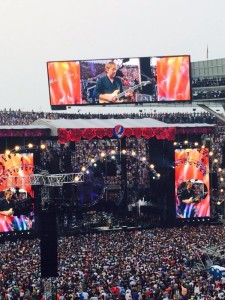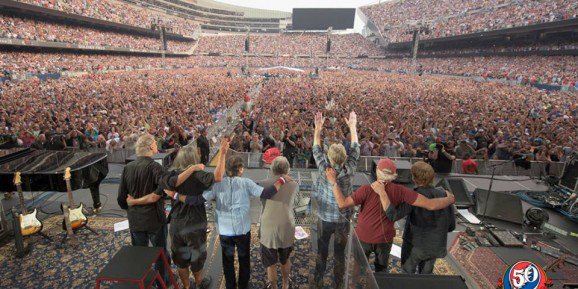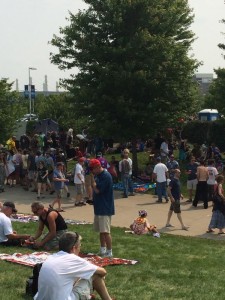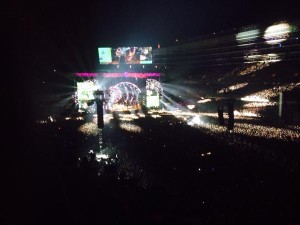They were there for hours that hot summer day and I know because I was there for hours, too, walking through the greenery by the Field Museum and the south parking lot. I saw people begging for spare tickets holding up signs reading “I need a miracle.” I saw people in dirty khakis sitting on the grass playing acoustic guitars and selling everything from bottled water to jerk chicken burritos, from jewelry to bowls. I saw tailgaters who gave anyone who liked their little set-up a free beer. I saw elementary school girls bravely dressed in teddy bear costumes. I saw more tie-dye and vintage T-shirts (not thrift store vintage but owned and lived in for years, cherished vintage) then I’ll ever see in one place again.
It was the largest audience in the history of Soldier Field – 71,000 people – and they had gathered to see history that was not just Chicago’s but America’s. They came to see the last performance of the Grateful Dead.
Searching for the Sound
Any event with so much public anticipation necessarily carries the weight of tremendous expectations, but whatever one can say of the final night of a five-show stretch the band dubbed Fare Thee Well, it was not a disappointment, and there were two primary reasons for this: the form and the content.
Beginning with the form; it is an adage beyond the Deadhead community that the Grateful Dead never played the same show twice. This is true, but these casual listeners may not be aware that the group’s overall sound continually transformed over the years. 1970 shows sound nothing like ones from 1972, which sound nothing like 1977, 1985, or 1990, as the band’s goals and repertoire evolved. When the Dead played what would have gone down as their last concert in 1995 at Soldier Field, their music had become, except for occasional nights of brilliance, lazy and repetitive, with songs stretching out over ten minutes and going nowhere when once they had been firecrackers as a dying Jerry Garcia couldn’t hold a lick together and forgot lyrics yet was so loved everyone deferred to him.
 The 2015 Grateful Dead were 180 degrees from this. I have heard hundreds of Dead tapes but never in my life had I heard the songs they played on July 5th in this style before. Right out of the gate, with an increasingly intense “China Cat Sunflower/I Know You Rider” opener, this band was almost deafeningly loud and incredibly driven. When the Modern Jazz Quartet played their own celebrated last concert in 1976, pianist John Lewis told Nat Hentoff that they knew this was their final chance to play their songs the best they could be played, and this attitude also could be seen in the Dead. Every song was jammed to the fullest, not from directionless noodling but a sense of everyone wanting to explore the harmonies and melodies one final time and see what uncharted musical territory could be conquered.
The 2015 Grateful Dead were 180 degrees from this. I have heard hundreds of Dead tapes but never in my life had I heard the songs they played on July 5th in this style before. Right out of the gate, with an increasingly intense “China Cat Sunflower/I Know You Rider” opener, this band was almost deafeningly loud and incredibly driven. When the Modern Jazz Quartet played their own celebrated last concert in 1976, pianist John Lewis told Nat Hentoff that they knew this was their final chance to play their songs the best they could be played, and this attitude also could be seen in the Dead. Every song was jammed to the fullest, not from directionless noodling but a sense of everyone wanting to explore the harmonies and melodies one final time and see what uncharted musical territory could be conquered.
The seven-piece lineup was perfectly balanced. The four original members may have been a step slower than in the seventies but otherwise had undimmed talent. Bill Kreutzmann kept the steadiest of beats on the drums while Mickey Hart jammed on every percussion instrument they could fit on stage…and seeing them duet on thirty different pieces on top of Hart’s programming was thrilling. Bob Weir, clad in shorts as always, alternated between rhythmic changes and bluesy leads with aplomb, while Phil Lesh, tall, thin, and still wearing his trademark sweatbands, traveled the entire range of bass lines and tempos. Equally important, Phil and Bobby’s voices have barely changed.
Rounding out the group, Bruce Hornsby, the chart-topping musician who loved the Dead so much he once sat in with them for eighteen months, returned to the piano chair with his gifts for lyricism and improvisation, while Jeff Chimenti crushed the organ (I saw him playing it by pressing his palms into multiple keys). The main newcomer, of course, was Trey Anastasio, who perfectly filled in for Jerry. You can watch old Dead footage and see Jerry sparkle with glee when he really felt a song moving, and Anastasio was gleeful all night, staring into the crowd with a sober but over-the-moon smile. The galvanizing moment of the night was the second song, “Estimated Prophet,” when during the first guitar jam Trey motioned Bob over and, with Phil as mediator, they traded increasingly screaming riffs; from that moment on the band refused to let up. It was only equalled by Trey’s one solo lead vocal of the show, when he took the reins for “Althea” and helped make it a thing of beauty.
Giving Them Something Built to Last
For all the musical prowess, what made the last concert a success was that the Grateful Dead didn’t treat it like a last concert. They clearly felt no obligation to include many of the songs which Deadheads obsess over–“Dark Star,” “The Other One,” and “Morning Dew” to name possibly the big three–and this worked because then the pressure would have been on to make these the definitive versions or close approximations. Instead, 7/5/15 was a show that touched on music from the beginning to the end of their career, and like all great Dead shows, it had thematic centers if not real storytelling. Half the show featured Jerry and lyricist Robert Hunter’s most mystical and otherworldly songs, reflective of the aura the Dead have built up since the acid tests with Ken Kesey. (The highlight was the romantic “Althea” bleeding into their epic of storytelling and tradition itself, “Terrapin Station.”)
The other half were songs about time passing, traveling (yes, there was a fiery diesel engine of a “Truckin'” to start the second set), and things falling apart and coming together. In one moment which was almost certainly intentional but no less wonderful, the group cranked the amps to 12 and played the most extraordinary version of their underrated 1990 song “Built to Last” I’ve ever heard, and immediately started jamming on “Samson and Delilah,” a song with the chorus “If I had my way, I would tear this whole building down.”
There were even nods to the present. “Throwing Stones,” Bob’s screed against the power elite and human self-destruction, sounded angrier and more urgent now in 2015 than in 1987, and coming out of the second set improvisations, Phil sang his 1974 classic “Unbroken Chain,” which features these lyrics that seem all too fitting for past year of Ferguson, Baltimore, and marriage equality:
“Willow sky, whoa, I walk and wonder why
They say love your brother but you will catch it when you try
Roll you down the line boy, drop you for a loss
Ride out on a cold railroad and nail you to a cross”
Music From the Secret Space of Dreams
It wasn’t a perfect show. Part of what made the Dead great was they would take whatever risks they felt like and foil perfection. “Unbroken Chain” is so complex that the band took too much time to settle into its rhythm. Bob not only forgot lyrics but at one point forgot he was supposed to be singing! And the whole show ended with “Attics of My Life,” which sets some of Robert Hunter’s most beautiful words to something that’s not a melody and falls apart really fast.
But that came after an aching, tear-inducing “Days Between” (the song Hunter and Jerry wrote as an elegy to the band’s past), the 70,000-strong sing-along “Not Fade Away,” and an ecstatic, raving “Touch of Grey” which again made Soldier Field sing as one.
I was sitting next to the person who sold me my ticket, someone who has been going to Dead shows since the early seventies. Halfway through the second set, this person whispered to me that I was seeing the Grateful Dead with Jerry Garcia. The energy of the crowd and the band resurrected his presence so he could make sure they would end it right this time.
I’m not sure how much I agree with that, but I do know that when Mickey Hart told the crowd to take what they felt in this moment, go out, and be kind to the world and the people in it, Jerry and many others we have lost along the way had to be approving.
Fare thee well.
Top photograph from Glide Magazine. All others taken by the author.







